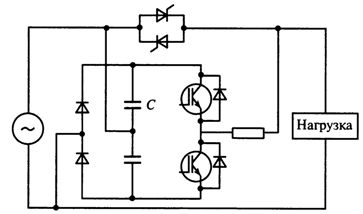Low voltage protection devices
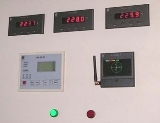 Consider different systems to protect industrial production from voltage drops (flywheel, static uninterruptible power supply (UPS), dynamic voltage distortion compensator, static compensator (STATCOM), parallel connected LED, boost converter, active filter and series amplifier without transformers) .
Consider different systems to protect industrial production from voltage drops (flywheel, static uninterruptible power supply (UPS), dynamic voltage distortion compensator, static compensator (STATCOM), parallel connected LED, boost converter, active filter and series amplifier without transformers) .
Voltage reduction is one of the most expensive phenomena in the industry. The easiest way to protect sensitive processes from any damage is to UPS installation... However, due to the high costs of their purchase and maintenance, UPS are installed only in large structural objects, in places where damage caused by power supply problems can to cause significant damage, for example in hospitals, in the production of computers, in financial institutions.
When deciding to install protective equipment, a feasibility study should be performed to show the feasibility of installing a UPS for a specific production process.
The problem of protecting electric motors with different speeds in industrial production from voltage drops has now been solved. Due to the wide variety of brands of such systems, it is not very easy to find the optimal technical and economic solution to this problem.
Types of corrective equipment
A motor-generator flywheel (D-G) can protect critical production disturbances from all voltage sags in the power system C. When a voltage sag occurs, the voltage drop across the load is slowed by the flywheel. The various schemes for connecting the flywheel to the motor-generator are similar to those shown in 1.
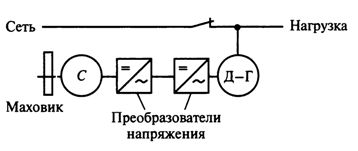
Rice. 1. Scheme of using a flywheel to compensate for voltage drops
The main components of an independent static UPS are shown in fig. 2, whose batteries (capacitors) store energy only to protect against voltage drops for a short time. If a voltage drop occurs, the load is powered from the battery via a DC-to-AC converter.

Rice. 2. Scheme of using a UPS to compensate for voltage drops
Compensator of dynamic voltage distortion during the voltage drop it remains connected to the electrical network 1 through the transformer 2 and determines the missing part of the voltage (Fig. 3). It adds this missing part of the voltage through the primary 4 and secondary 3 windings of the autotransformer connected in series with the load 7. Depending on the purpose, the energy to supply the load 7 through the voltage converter 5 during the voltage drop can be taken from the network or from an additional power source (mainly from capacitors c).
Consider two modifications from different manufacturers. The first (hereinafter referred to as DKIN-1) does not contain power sources and is permanently connected. This option is cost-effective to increase the voltage up to 50%. There is a modification of the DKIN device with the ability to increase the voltage by 30%. It is believed that starting with this modification of the DKIN device (30%), it is advisable to use them in production.
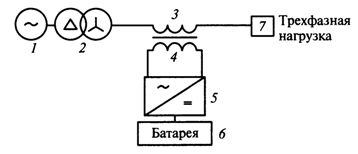
Rice. 3. Scheme for using DKIN to compensate for voltage drops
The second modification (DKIN-2) contains a power source designed for a heavy load. The two-megawatt device can increase the load voltage of a 4 MW load by 50% or an 8 MW load by 23%. Unlike most other devices, the power source is able to withstand prolonged drops.
Static compensator (STATCOM) A voltage drop compensation device is connected in parallel with the load (Fig. 4). A STATCOM device can reduce voltage drops by changing the reactive load at the junction.
The ability to reduce dips can be improved by adding an additional power source, such as a superconducting magnetic power source. Although STATCOM compensators (Fig. 4) are capable of absorbing and returning reactive power VStatistically, their use is usually limited to static compensation for economic reasons.
In step-down mode, the STATCOM system switches to DC source mode. The voltage across the capacitor terminals can be kept constant.
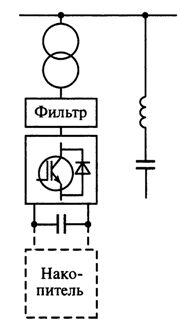
Rice. 4. Static expansion joint
A parallel-connected synchronous motor (SM) is somewhat similar to a STATCOM, but contains no power electronics (Fig. 5). The ability of the synchronous motor to provide a large reactive load allows such a system to compensate voltage drops up to 60% deep within 6 s. At the same time, a small flywheel protects the load from a complete power failure for 100ms.
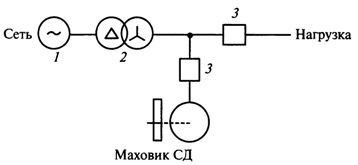
Rice. 5. LED and flywheel connected in parallel: 1 — power system; 2 — transformer; 3 — switch
Step-up converter This is a DC / DC converter that increases the DC bus voltage (for example, a variable frequency motor) to the nominal level (Fig. 6).
The largest voltage drop that can be compensated depends on the rated current of the boost converter. The boost converter starts working as soon as a voltage drop is detected on the device's DC buses. Along with the ability to compensate for symmetrical voltage drops of up to 50%, the boost converter has the ability to compensate for deep asymmetrical drops, such as a complete failure of one of the phases. The boost converter can be supplemented with batteries to protect against total power failure.
An active filter (fig. 7) is a converter that works like a rectifier, using IGBT thyristors instead of diodes.
An active filter can maintain the voltage continuously through the voltage drop. The current rating of the active filter determines the maximum voltage drop correction value.
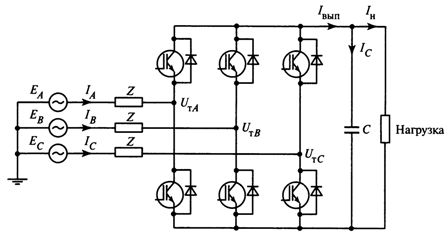
Rice. 7. Active filter
In the event of a voltage drop, a transformerless voltage compensation circuit (Fig. 8) opens and the load is fed through the inverter.The DC bus power supply of the inverter is supported by two capacitors charged in series.
Rice. 8. Series voltage drop compensation without transformers
For a residual voltage of 50%, the rated voltage level can be provided. In this device, additional supplies (capacitors) can mitigate the complete interruption for a limited period of time. The device provides the ability to restore the voltage even with asymmetric voltage drops.

